By Delmar Cain, Boerne Chapter, Native Plant Society of Texas
If you want to see spring wildflowers in the Hill Country, I am not sure that you will have a better year than this to take a drive and enjoy them. The plentiful rains did their part to promote the bluebonnets, Indian blankets, cut-leaf daisies and Texas paintbrushes early in the year and in unexpecte d locations. Even if you were not planning on it, a drive north on FM 474 north of Boerne to FM 473 woul d be worth your time.
But of course those wonderful rains encourage more than the beautiful bloomers. A few pests are ready to make sure that their seeds are spread as far as possible in these favorable conditions. I am referring to the burr clover (Medicago polymorph), stickywilly (Galium aparine), common hedge parsley (Torilis arvensis) and that sneaky low-down, seed header, Malta-star thistle (Centaurea melitensis). The only one of these four that is native is the stickywilly. The burr cover was introduced for disturbed areas and for foraging for some livestock. But all of these plants are aggressive and the seeds all seem attracted to the long hair of Scout, our golden retriever.
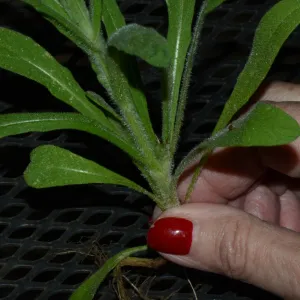
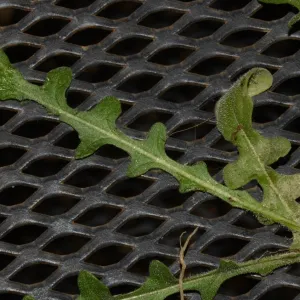
I also want to alert you that this is a year to be especially vigilant for Malta-star thistle. I thought that I had carefully removed all of the plants from my yard only to find 20 or so that had escaped my eye. One plant was 18 inches tall and had remained unnoticed in tall grass, even though I walked by it every day. Another plant was even more surreptitious. Its leaves did not have the usual shape of the leaves of the plant, yet it had the seed head (Photo of plant #1). Its lower leaves had smooth edges, which closely resembled those of an Indian blanket. The more usual leaves of Malta-star thistle can be seen in the photo of plant #2. Again at the risk of sounding like a broken record (could that phrase be coming back in style), the first or lowest seed head on this plant will not be eliminated by a mowing. The plant will proliferate.
But surely we can discuss something more pleasant in this wonderful Texas spring. And what could be more pleasant than a Wahoo tree, also commonly known as a Lemonball, a Littleleaf leadtree and in this part of the Hill Country, a Goldenball leadtree. Its scientific name is Leucaena retusa and it is the NICE (Natives Instead of Common Exotics) Plant of the Month for April, recommended by the Boerne Chapter of NPSOT (Native Plant Society of Texas).
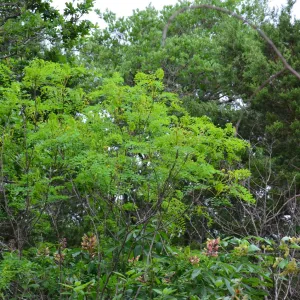
A tree called a “Wahoo” yells to me that there is a story somewhere. Unfortunately I did not find it. Another small native tree located farther east is called the Eastern Wahoo (Euonymus atropurpureus). It has very bright red berries in the fall. Finding colorful golden balls on a small tree in West Texas in the summer seems just as deserving of loud Wahoo as finding the red berries in the east. I will defer to the Wildflower Center in Austin, where I got the common names, to improve on the story.
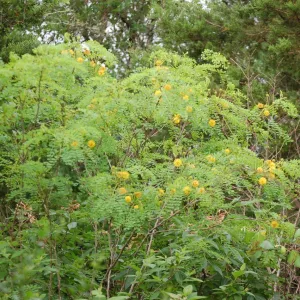
The Goldenball leadtree is native to our area and to the rocky slopes farther west into New Mexico and south into Mexico. Growing in full or partial sun and in proper soil it may grow to a height of 25 feet. This deciduous tree has bright green bipinnately compound leaves that only filter the sun. Given its native habitat, it is very drought tolerant and should be situated in an area with good drainage.
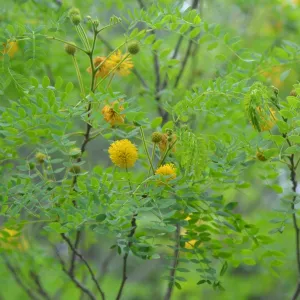
In the spring the Lemonball develops golden or yellow puff flowers and continues to flower, especially after rain, into the fall. It grows quickly but has brittle wood. Deer will browse its leaves, but its quick growth puts its leaves above browse level in a few years. I keep mine fenced to keep the bucks from rubbing the trunk in the fall. It is a decorative tree that I enjoy having in our yard. Planting instructions can be found on the Boerne Chapter website and the trees are available at local nurseries.
The Boerne Chapter of NPSOT will be hold its regular meeting on May 3rd at the Cibolo Nature Center auditorium in Boerne at 6:30 PM. Ernesto Carino and Ysmael Espinosa of Medina Garden Nursery will present a program on Permaculture and Butterfly Gardens. If you have seen the butterflies and the beautiful blooming flowers, shrubs and trees at Medina Garden Nursery, you understand why Ernesto and Ysmael are frequently requested to speak about their methods and ideas that lead to such horticultural successes. I am sure that this program will be filled with insights. The public is welcome.


